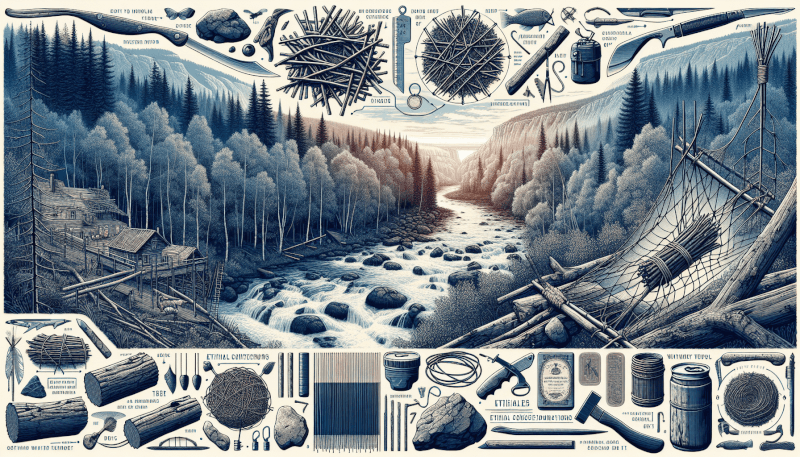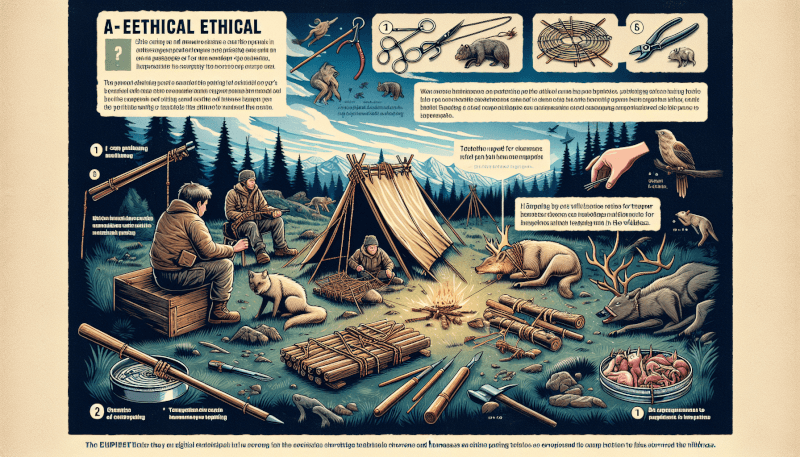In “The Bushcraft Field Guide To Trapping,” you are taken on an exciting journey into the world of survival skills and wilderness knowledge. This comprehensive guide is packed with valuable insights and techniques that will help you navigate the art of trapping in the great outdoors. From setting up effective snares and traps to identifying animal tracks and behavior, this guide provides you with the essential tools to become a skilled trapper. Whether you are a beginner or an experienced outdoorsman, “The Bushcraft Field Guide To Trapping” will equip you with the knowledge and confidence needed to thrive in the wilderness.
Understanding Trapping
Trapping is an essential skill in bushcraft that allows you to capture animals for various purposes, such as obtaining food, gathering resources, or conducting research. By understanding trapping techniques and practices, you can become more self-reliant and enhance your survival skills in the wilderness.
Importance of trapping in bushcraft
Trapping plays a crucial role in bushcraft for several reasons. First and foremost, it provides a sustainable source of food when other means of hunting may be limited. Trapping allows you to target specific animal species, increasing your chances of successful food procurement.
Additionally, trapping enables you to gather valuable resources from animals, such as fur for clothing and shelter insulation, bones for tools and weapons, and sinew for cordage. These resources can significantly enhance your bushcraft gear and contribute to your overall survival in the wilderness.
Moreover, trapping offers an opportunity to study animal behavior and habitats. By observing and analyzing animal tracks and signs, you can gain valuable insights into the local wildlife population, facilitating a deeper understanding of the ecosystem you are a part of.
History of trapping
Trapping has a rich history dating back thousands of years. In ancient times, humans relied on trapping as a primary method of obtaining food and pelts for warmth. Native American tribes, for example, perfected their trapping techniques to sustain their communities and meet their various needs.
Over time, trapping evolved from a necessity for survival to a commercial industry. Fur trading played a significant role in the colonization of various regions around the world, with explorers and settlers relying on trapping for economic purposes.
Today, trapping is both a traditional skill passed down through generations and a recreational activity enjoyed by many outdoor enthusiasts. It continues to be an integral part of bushcraft and survival knowledge.
Types of traps
Traps come in a variety of types, each designed to target specific animal species and habitats. Some common types of traps include:
Snares: Snares are simple yet effective traps consisting of a noose made from wire or cordage. They are used to capture animals by tightening around their necks or limbs when triggered, ultimately restraining them.
Deadfall traps: Deadfall traps rely on the principle of gravity to immobilize and trap animals. They typically involve a heavy object or structure that is triggered when an animal disturbs the bait, resulting in the trap’s collapse and immobilization of the prey.
Pitfall traps: Pitfall traps are holes dug into the ground and concealed with natural materials to capture animals that fall into them. These traps take advantage of the animals’ natural behavior, such as following scent trails or looking for food, leading them into the pitfall.
Conibear traps: Conibear traps are designed to quickly kill or immobilize animals upon triggering. They consist of a powerful spring-loaded device with two square jaws that snap shut, capturing the animal’s body or neck.
Foot hold traps: Foot hold traps are widely used in professional trapping and carefully designed to hold an animal’s foot without causing excessive harm or injury. They allow for easy release or dispatching of the captured animal.
These are just a few examples of traps used in bushcraft. The choice of trap depends on the target species, local regulations, and specific circumstances.
Essential Trapping Skills
To become proficient in trapping, it is essential to develop a range of skills that will increase your chances of success in the field. The following skills are critical to master for effective trapping in a bushcraft setting.
Identifying animal tracks and signs
One of the most fundamental skills in trapping is the ability to identify animal tracks and signs. By studying footprints, scat, markings, and other indicators left by animals, you can determine the presence of target species and their habits. Familiarizing yourself with common tracks and signs will enhance your tracking abilities and increase your chances of successful trapping.

Animal behavior and habits
Understanding animal behavior is key to successful trapping. By observing and studying the habits of different species, you can predict their movement patterns, feeding routines, and preferred habitats. This knowledge allows you to strategically place your traps in locations where animals are most likely to encounter them, increasing your trapping efficiency.
Setting up trap lines
Setting up a trap line involves strategically placing traps along a predetermined route to maximize the chances of capturing animals. A well-designed trap line considers factors such as animal movement, terrain features, and food sources. By carefully planning and implementing your trap line, you can cover a larger area and increase your trapping success.
Selecting trapping locations
Choosing the right trapping locations is crucial for a successful trapping expedition. Factors to consider when selecting trapping sites include identifying high-traffic animal areas, natural funnels, and signs of animal activity. By placing traps near these locations, you increase the likelihood of capturing your target species.
Choosing the Right Traps
When it comes to selecting traps for bushcraft trapping, several considerations come into play. Different types of traps are designed for specific purposes and target species. Understanding the various traps available and matching them to your intended prey is essential for successful trapping endeavors.
Introduction to different types of traps
As discussed earlier, traps come in various forms, each with its specific features and uses. Snares, deadfall traps, pitfall traps, conibear traps, and foot hold traps are just a few examples. Learning the characteristics and functions of each trap will allow you to choose the most effective option for your specific bushcraft trapping needs.

Selecting traps based on target species
Different animals have different habits, sizes, and behaviors. As such, selecting the appropriate trap for a specific target species is crucial. Factors to consider include the size of the animal, its agility, and its natural behaviors. Traps must be strong enough to hold the animal without causing undue harm or allowing it to escape.
Understanding trap regulations and legalities
Before embarking on any trapping expedition, it is essential to understand the relevant trap regulations and legalities in your area. Each region may have specific rules regarding the types of traps allowed, the target species, trapping seasons, and reporting requirements. Adhering to these regulations is not only important for legal compliance but also ensures the sustainability and conservation of wildlife populations.
Preparing Traps
Proper preparation of traps is vital to ensure their effectiveness and maximize your trapping success. Regular maintenance, modifications, and the use of suitable attractants and bait can significantly enhance the performance of your traps.
Cleaning and maintaining traps
To ensure proper functionality, it is crucial to regularly clean and maintain your traps. Rust, dirt, and debris can hinder trap mechanisms and reduce their efficiency. Cleaning traps with a wire brush and applying lubrication to moving parts will help prevent rust and ensure smooth operation. Regular inspections should also be conducted to identify and replace worn-out or damaged components.
Modifying traps for specific purposes
Sometimes, modifying traps to suit specific hunting scenarios or target species can be beneficial. Adding trigger mechanisms, altering bait placement, or adjusting tension settings can increase the efficiency of your traps. Careful experimentation and testing of modifications will help fine-tune trap performance in different conditions.

Setting up bait stations and attractants
Attracting animals to your traps is key to successful trapping. Setting up bait stations near your traps can entice animals to approach and interact with the trap. Bait options include food items like meat, fruits, or sweet-smelling substances. Learning about the preferred food choices and smells of the target species will help you select suitable bait and increase trapping success.
Setting Traps in the Field
Properly setting traps in the field requires careful planning, attention to details, and comprehension of animal behavior. Ensuring optimal trap placement and disguising traps from animal eyes is essential for successful trapping.
Planning trap placement
Before setting traps, thoroughly analyze the terrain, identify animal tracks and signs, and study the local environment. By understanding the target species’ movement patterns and habits, you can strategically place traps in locations where animals are likely to encounter them. Taking advantage of natural funnels, trails, and feeding areas will increase your trapping success.
Building natural camouflage for traps
Animals are naturally cautious and wary of foreign objects in their environment. Building natural camouflage for traps plays a crucial role in tricking animals into approaching without suspicion. Using leaves, debris, branches, and other natural materials to conceal and blend traps with the surroundings helps to increase the chances of capturing your intended prey.
Avoiding common trapping mistakes
Even with careful planning and execution, certain common trapping mistakes can compromise your success. Avoiding errors such as insufficiently securing traps, using improper bait techniques, or neglecting to account for wind direction requires attention to detail and continuous improvement. Learning from these mistakes and adjusting your trapping methods accordingly will enhance your overall trapping effectiveness.
Checking and Maintaining Traps
Traps require regular checking and maintenance to ensure their continued functionality and to minimize unnecessary animal suffering. Routine trap checks, replacement of worn-out parts, and preventing damage to traps are important aspects of responsible trapping.

Routine trap checks
Checking traps at regular intervals is crucial for ethical and effective trapping. Routine trap checks minimize the amount of time animals spend captured, reducing their stress and potential harm. Checking traps also allows you to release non-target species or undersized animals, ensuring selective trapping and conservation.
Replacing worn-out parts
Components of traps, such as springs, triggers, and cables, can wear out over time with repeated use. It is essential to inspect these parts regularly and replace worn-out components to maintain the traps’ effectiveness. This includes checking for rust, frayed wires, and weakened structural components.
Avoiding damage to traps
Traps can be vulnerable to damage from various factors, including weather, wildlife interactions, and other environmental conditions. Taking steps to protect traps from exposure to moisture and extreme temperatures, as well as avoiding locations prone to vandalism or theft, will help extend their lifespan and ensure ongoing trapping success.
Animal Handling and Dispatching
Trapping involves capturing live animals, and it is essential to handle them ethically and responsibly. Proper animal handling techniques and effective dispatching methods are critical for reducing stress and ensuring quick, humane outcomes for trapped animals.
Ethical considerations in trapping
Ethics in trapping revolve around minimizing animal suffering, promoting conservation through selective trapping, and respecting animal welfare. It is important to prioritize the humane treatment of trapped animals and to handle them with care and respect throughout the trapping process.

Humane animal handling techniques
When handling live animals, it is crucial to minimize stress and prevent unnecessary harm. Proper handling techniques involve using appropriate equipment, such as gloves and restraining devices, to minimize direct contact and safeguard both the trapper and the captured animal. Calm and quiet interactions help reduce stress levels for the animal, ensuring a more humane trapping experience.
Effective methods of dispatching trapped animals
Dispatching trapped animals is a necessary part of ethical trapping. Quick and humane dispatching methods, such as the use of firearms or specialized tools, minimize suffering and ensure a swift end for the captured animal. Choosing the appropriate method for dispatching requires an understanding of local regulations, safety considerations, and appropriate equipment.
Processing and Utilizing Trapped Animals
Trapped animals provide valuable resources that can be utilized for food, clothing, tools, and various other purposes. Properly processing and utilizing trapped animals is an important part of responsible trapping and survival in bushcraft.
Skinning and preserving animal pelts
The fur and hide of trapped animals can be used for various purposes, including clothing, blankets, and shelter insulation. Proper skinning techniques ensure the preservation of the pelt, maximizing its usability and quality. Learning the art of skinning and preserving animal pelts is essential for effectively utilizing this valuable resource.
Preparing animal meat for consumption
Trapped animals can serve as a valuable source of food in a survival situation. Properly preparing and cooking animal meat ensures its safety and palatability. Learning about different cooking methods, seasoning techniques, and meat preservation methods will help you make the most of your trapped animal as a food source.
Utilizing other parts of trapped animals
Besides meat and pelts, trapped animals offer a variety of other useful resources. Bones can be used for tools, weapons, or shelter construction. Sinew can be transformed into cordage for binding materials together. These additional parts of trapped animals should not be overlooked, as they hold immense potential for enhancing your bushcraft skills and overall survival in the wilderness.
Trapping for Survival Situations
In survival situations, trapping takes on even greater importance. When traditional means of obtaining food are scarce or inaccessible, trapping allows for sustained nourishment and the conservation of energy and resources.
Importance of trapping for survival
Trapping is a critical skill in survival situations as it provides a sustainable source of food when hunting may be limited. By setting up efficient trapping systems, you increase your chances of capturing animals while conserving energy and minimizing risk. Trapping allows you to focus on other critical survival tasks while ensuring a consistent food supply.
Building emergency snares and improvised traps
In survival scenarios, you may not always have access to pre-made traps. Knowing how to build emergency snares and improvised traps from readily available materials is crucial. These traps can be quickly constructed and provide a valuable means of capturing small game or surviving in unexpected survival situations.
Using trapped animals as food and resources
When trapped animals are successfully captured, they become a vital resource for survival. Utilizing the meat for food, the pelts for clothing and insulation, and other parts for tools and material significantly enhances your chances of survival. Trapped animals become the cornerstone of your sustenance and the foundation of your survival provisions.
Trapping Safety and Ethics
Trapping involves a responsibility to ensure the safety of both trappers and the captured animals, while also maintaining ethical standards. Understanding potential hazards, practicing respectful behavior towards wildlife, and adhering to ethical trapping practices are critical in maintaining a sustainable and responsible approach to trapping.
Avoiding potential hazards and accidents
Trapping can involve various risks and hazards. It is essential to be aware of potential dangers such as sharp trap components, animal bites, and injuries caused by misuse of trapping equipment. Staying vigilant, using appropriate protective gear, and adhering to safety guidelines will help minimize the risk of accidents during trapping activities.
Respecting wildlife and the environment
Trapping is inherently tied to the welfare of wildlife and the overall health of the environment. It is crucial to respect and appreciate these interconnected aspects while engaging in trapping activities. This includes avoiding unnecessary harm to non-target species, minimizing disruption to natural habitats, and adhering to local regulations governing trapping practices.
Following ethical trapping practices
Ethics in trapping encompass responsible behavior, minimizing animal suffering, and fostering conservation. Ethical trapping practices involve prioritizing animal welfare, selective trapping to preserve populations, and responsible utilization of trapped animals. Trappers must strive to maintain the highest ethical standards throughout every stage of trapping, from planning to dispatching and utilizing trapped animals.
Conclusion
Trapping is a fundamental skill in bushcraft that offers opportunities for sustenance, resource gathering, and survival. By understanding the importance of trapping, mastering essential trapping skills, choosing the right traps, properly preparing and setting traps, and handling captured animals with care and respect, you can become proficient in this vital survival practice. Remember to prioritize safety, follow ethical guidelines, and maintain a deep respect for wildlife and the environment as you develop your trapping abilities in the world of bushcraft.


